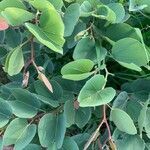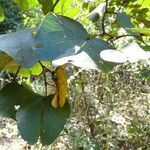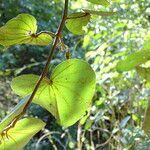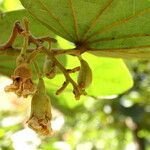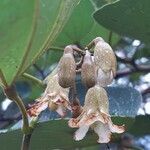Tree up to 10 m high or sometimes a shrub; bark rough, dark brown to grey or black; young branchlets rusty-tomentellous or shortly rusty-tomentose. Leaves: petiole 2-4 cm long; blade mostly 5-15 cm long and 6-16 cm wide in our area, bilobed apically about one-eighth to one-third of the length of the leaf, densely reticulate and rusty-puberulous or-pubescent beneath; lobes each with 5 or 6 main veins. Stipules 3-6 mm long. Panicles usually alternately leaf-opposed and axillary along the branches, the male ones 5-19 cm long and the female 2-7 cm long. Calyx 0.8-1.5(2) cm long, rusty-tomentose or-tomentellous. Petals white to pinkish, obovate, 1.2-2 (2.6) cm long, rugose or bullate, hairy on basal claw and outside of limb. Ovary 5-12 mm long, stigma sessile on the ovary. Pods woody, indehiscent, oblong or linear-oblong, mostly 13-20 cm long and 3-6 cm wide in our area, shortly ferruginous pubescent, on a stipe 2-3 cm long. Seeds obovoid to ellipsoid, somewhat compressed, dark brown to blackish, 7-9 mm long, 5-7 mm wide and 3-4 mm thick. Flowering period is from November to April.
It is a leafy shrub or a spreading tree. It loses its leaves during the year. It can grow to 12 m tall. The leaves are broad and lobed. The bark is rough and brown. The leaves are simple and can be 20 cm across. The tip of the leaf has lobes and the base of the leaf has notches. The veins spread out from this notch. The upper surface of the leaf is green and the lower surface a lighter colour and with red veins. The leaves are on thick stalks. The male and female flowers are carried separately. The male heads have fewer flowers than the female. The flower buds are fat and oval. They are velvety and in long strings on sturdy stalks. The flowers are 2.5 cm wide. Only one or two flowers open at one time in a bunch. They hang downwards and drop off easily. The pods are large and woody. They are up to 23 cm long by 8 cm wide. They are green but turn brown. They are covered with tiny raised lines. The pods do not break open but fall off. The pods and seeds are edible
Tree (2–)3–10 m. high, occasionally shrubby.. Bark rough, dark brown to grey or black.. Branchlets rusty-tomentellous or shortly rusty-tomentose when young.. Leaves mostly 5–17 cm. long and 6–19 cm. wide, bilobed about one-eighth to one-third way down, densely reticulate and rusty-puberulous or-pubescent beneath.. Panicles usually alternately leaf-opposed and axillary along branches, the ♂ ones 5–19 cm. long, the ♀ 2–7 cm. long.. Flowers white to pinkish.. Calyx rusty-tomentose or-tomentellous, 1.3–2.3 cm. long.. Petals obovate, 1.4–2.6 cm. long, rugose or bullate, hairy on basal claw and outside of limb.. Pods stipitate, woody, oblong or linear-oblong, mostly 13–26(–37) cm. long and 3–6.3 cm. wide.. Seeds obovoid to ellipsoid, somewhat compressed, dark brown to blackish, ± 7–9 mm. long, 5–7 mm. wide and 3–4 mm. thick.. Fig. 46.
Leaves: petiole 2–5(7) cm; lamina up to 16 cm from base of midrib to tip of lobes, lobed for ?–? of its length, the angle between the lobes slightly less than to slightly more than 90°, usually strongly cordate at the base, the lobes rounded to acutely pointed, glabrous above, with rusty-brown crisped hairs beneath, the lower surface with a conspicuously prominent finely reticulate venation.
Dioecious, inflorescences of male trees forming very narrowly pyramidal panicles up to 20 × 5.5 cm; those of female trees forming short few-flowered panicles up to 7 cm long; axes and pedicels brown-tomentellous.
Tree or shrub, up to 10 m high. Leaves 2-lobed, 50-150 x 60-160 mm, densely reticulate and rusty-pubescent beneath. Pods woody, indehiscent, oblong or linear-oblong, 130-200 x 30-60 mm. Flowers white to pink.
Pods woody, 12–30(37) × 3–6.5 cm, varying from 2 to 10 times as long as broad, oblong to linear oblong, brown-pubescent when young but later glabrescent.
Shrub or small tree, to 25 ft. high, often of crooked growth and occasionally scrambling
Petals white to lilac or pink, 1.1–2 cm long, obovate, the margins strongly undulate.
Seeds dark brown to blackish, 7–9 × 5–7 × 3–4 mm, obovoid to ellipsoid, compressed.
Tree up to 10 m with a spreading crown, or occasionally flowering as a shrub.
Young branches with rusty-brown tomentum, somewhat glabrescent later.
Ovary brown-tomentose; style very short or absent; stigma capitate.
Stamens 10(11), scarcely reaching the throat of the flower.
Calyx 0.8–1.5 cm long, brown-tomentellous.
Petals white
